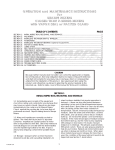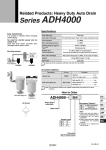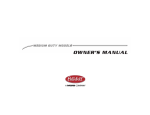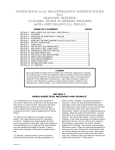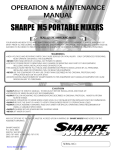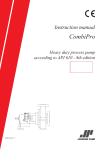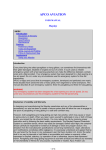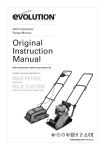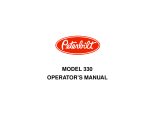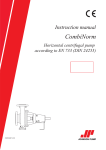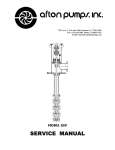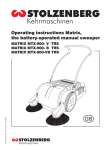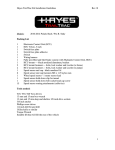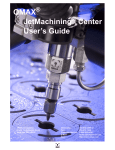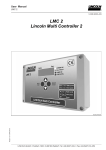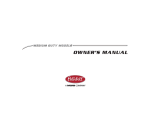Download V-SERIES SECTION B 5/02
Transcript
V-SERIES MIXER WITH STUFFING GLAND SECTION B TABLE OF CONTENTS SECTION A SECTION B SECTION C SECTION D MIXER DATA SHEET & DRAWINGS .............................................................................................................. A-1 INITIAL INSPECTION, RECEIVING AND STORAGE ..................................................................................... B-1 MOUNTING THE DRIVE ............................................................................................................................... B-2 INSTALLING THE MIXER IMPELLER ............................................................................................................... B-3 MOTOR CONNECTIONS & LUBRICATION ................................................................................................. B-4 STUFFING GLAND PREPERATION & LUBRICATION .................................................................................... B-5 START UP & OPERATION ............................................................................................................................. B-6 START-UP CHECK LIST .................................................................................................................................. B-7 V-SERIES MAINTENANCE & LUBRICATION ............................................................................................... C-1 SHAFT RETRACTION ................................................................................................................................... C-2 OUTER BEARING REMOVAL ...................................................................................................................... C-3 INNER BEARING REMOVAL ....................................................................................................................... C-4 STUFFING GLAND MAINTENANCE (Repacking) ..................................................................................... C-5 V-BELT MAINTENANCE .............................................................................................................................. C-6 TROUBLE SHOOTING GUIDE ...................................................................................................................... C-9 MISCELLANEOUS DETAILS & INSTRUCTIONS (when required) ..................................................................... INITIAL INSPECTION, RECEIVING AND STORAGE has been delayed, c) there are long idle periods of time between operating cycles, store the mixer in a clean, dry location, with circulating air, free from wide variations in temperature. Electric motors are easily damaged by moisture. Store the entire unit off the floor, covered with plastic, and use desiccants to reduce moisture buildup. If the motor shows signs of moisture absorption before start-up, dry the motor out by applying 10% voltage on two leads ( if in doubt, measure resistance in windings, one to three meg-ohms is normal). Relubricate motor before start-up when in storage six months or more. V-Belts are best stored by removing them from the sheaves. Spray a metal protectant on the sheaves or any other unprotected mild steel part. Remove all the metal protectant before reinstalling belts. Mixer shaft bearings require extra protection when stored. Add grease until it shows at the seals, rotate bearings to distribute grease, and cover the bearings. B1.1 This mixer has been inspected at the factory. Immediately upon receipt of the equipment check the crating and contents for any damage that may have occurred in transit. Check against the packing slip and the certified drawings in section A to make sure that all parts were received. Report any damage or missing items immediately to the carrier and to Sharpe Mixers. Keep shipping containers for possible future storage or shipping. B1.2 WHEN LIFTING THE EQUIPMENT USE NON-METALLIC SLINGS TIGHTENED AROUND THE MIXER HOUSING. Verify all loads are balanced before lifting. Do not stand underneath suspended loads. Do not lift the mixer by the shaft. Do not lift the mixer using the motor lifting lug alone. B1.3 Storage: Storage is when a) mixer has been delivered to the job site and is awaiting installation, b) mixer has been installed, but start up LIFT MIXER USING SLINGERS TIGHTENED AROUND THE MIXER HOUSING BS - 7441 - 1 - 2000 DO NOT LIFT THE MIXER BY THE SHAFT B-1 MOUNTING THE DRIVE B2.3 Tie Rod supports need to be positioned on each side of mixer at 45° above centerline and 45° from mixer centerline and securly attached to the tank. After installing the flange mounting bolts tighten the tie rods until the weight of the mixer has been transfered equally between the nozzle and the tie rods. See figure B2.2 for mounting details. B2.1 Mounting structure must be stable and strong enough to handle torque, bending moment, and weight shown on assembly drawings. The structure must not flex or vibrate when the mixer is in operation. If mounting to an unstable support, mixer loads may cause damage to the equipment, tank, or other hazards. Always use gaskets between flange faces before bolting the mixer to the nozzle for proper sealing. See figure B2.0 for mounting details. B2.4 Pier supports need to be built under the base of the V-Series housing. After installing the flange mounting bolts, shim the pier until the weight of the mixer has been transferred equally between the pier and the nozzle. See the assembly drawing in Section A for stud location. See figure B2.3 for mounting details B2.2 Pipe leg supports are normally supplied on V-Series mixers. These aid in the support of the mixer and need to be attached securely. Pipe legs and bases (by others) must be cut to lenght and threaded to match the pipe leg supports. After installing the flange mounting bolts tighten the pipe leg supports until the weight of the mixer has been transfered equally between the nozzle and the pipe legs. The specific size and location of the pipe legs are called out on assembly drawing in Section A. See Figure B2.1 for mounting details. (The pipe leg supports may ship in a separate box from the drive and may require assembly to the drive during installation). 6" TANK CENTERLINE AFT AND MIXER SH G ENTERLIN NOZZLE C 7° PLAN VIEW FIGURE B2.0 D D/2 + 6" Min PIPE LEG SUPPORTS FIGURE B2.1 45° D D/2 + 6" Min TIE ROD SUPPORTS FIGURE B2.2 D Shim D/2 + 6" Min PIER SUPPORT FIGURE B2.3 B-2 BS - 7441 - 2 - 2000 INSTALLING THE MIXER IMPELLER WARNING: Always lockout power before installing or removing impeller. B3.3 Split Hub Impellers: See figure B3.2. Align key and clamp split hub impeller to shaft. Be sure to maintain equal 1/4" gaps between hubs to insure correct blade alignment and vibration free operation. Tighten split hub impeller bolts to the following torque ratings in table below. If impellers where shipped with shims, discard prior to assembly, do not use to assemble on mixer shaft. B3.1 Refer to mixer assembly and impeller detail drawings in the front of the manual for proper impeller rotation, positioning, and placement. B3.2 1-Piece Impellers: See figure B3.1. Slide the impeller on the shaft facing the correct way (according to the assembly drawings). For impellers with keys, tighten the setscrew securely over the key. Do not hammer parts in place. If keys do not fit, grind to size. Bolt Torque Ratings (split impeller bolts only) 1/2" bolt @ 29 ft.-lbs. 5/8" bolt @ 54 ft.-lbs. 3/4" bolt @ 96 ft.-lbs. 7/8" bolt @ 150 ft.-lbs 1/4" GAP 1- PIECE HYFLO II SPLIT HYFLO II FIGURE B3.1 FIGURE B3.2 MOTOR CONNECTIONS & LUBRICATION B4.5 WARNING: Ground the mixer motor properly to avoid serious injury to personnel. Grounding needs to be in accordance with the National Electrical Code and consistent with local building codes. B4.1 WARNING: High voltage and rotating parts can cause serious or fatal injury. Electric machinery can be hazardous. Installation, operation, and maintenance of electric machinery should be performed by qualified personnel. Familiarity with NEMA safety standards, National Electrical Code and local building codes are required. B4.6 Electric AC Variable Speed: Electric motors using an AC variable frequency controller must be wired following the instructions supplied with the controller. See data sheet and assembly drawings for possible RPM lockout ranges. Operate only at speeds outlined on those sheets. Damage to equipment or serious injury to personnel can result, If speed limitations are not followed. B4.2 Wiring: Starting and overload control devices must be matched to motor rating. Follow control manufacturer's instructions for proper connections and installation. B4.3 Electrical connections must conform to National Electrical code and all local regulations. Line voltage and wire capacity must match motor rating stamped on motor nameplate. B4.7 Motor lubrication: Electric motor bearings are often sealed and need no relubrication. When zirc fittings are present, relubricate with a No. 2 consistency lithium soap base and petroleum compound. Relubricate every 6 months to 1 year depending on usage. Open and clean drains. Add grease until new grease is forced out drain. Remove excess grease and replace input plugs. Run motor one half hour before replacing drain plugs. B4.4 Electric motors - 3 phase: Motors requiring 3 phase power must be wired according to the wiring diagrams on the motor. Rotation of the impeller must be according to the assembly drawing and data sheet. Interchange lines if necessary for proper rotation. BS - 7441 - 3 - 2000 B-3 STUFFING GLAND PREPARATION & LUBRICATION B5.1 DO NOT OVER TIGHTEN THE PACKING! Stuffing glands are designed to control leakage, not to prevent it. During start-up permit generous initial leakage. Gradually take up gland nuts 1/6 turn (1 flat in hex nuts) at a time. Watch temperature. NEVER PERMIT HEAT TO DEVELOP - BACK OFF GLAND NUTS IF IT DOES. As leakage levels off on side entry units, tighten at 15 minute intervals until leakage is controlled without developing heat. On a 2" dia. side entry shaft, permit 10 to 30 drops per minute, a 4" shaft would be allowed to leak twice as much, etc. daily. Weight loaded lubricators or other self lubricating devices are available from Sharpe Mixers to aid in seal lubrication. When seal flushing is required remove the 1/8" zirc fitting and replace it with flushing lines (supplied by others). Flush with clean liquid having lubricating properties. B5.4 5-RING GLAND WITH THROTTLE BUSHING: A throttle bushing requires a constant flow of flush water during operation. One side of the gland is tapped for a 1/4" N.P.T. flush line, the other side has a fitting with a pin that holds the throttle in postion. (See figure C5.2) Install a rotometer (available from Sharpe Mixers) and adjust for 0.1-0.2 gal/min for 2" shaft to 0.3/0.5 gal/min for 5" shaft. B5.3 7-RING STUFFING GLAND WTH LANTERN RING LUBRICATION: Stuffing glands come with a zirc fitting on the side of the seal housing and should be greased regularly. When mixing abrasive nonlubricated liquids the zirc fitting should be greased FOR REPACKING THE GLAND SEE SECTION -C5- START UP & OPERATION B6.1 Before starting up, visually inspect the mixer. Verify that the mixer components matches the certified drawings in the front of the manual. B6.10 Extended operation of the mixer when liquid level is at or near the impeller is not recommended. Excessive loading and vibration will occur. B6.2 Check all mounting and impeller bolts. Verify that they are installed and have been tightened. B6.11 When mixing products of dissimilar viscosities and/or specific gravities the lighter or less viscous material should be introduced first. Gradually add the heavier material or powders into the center of the tank while the agitator is running. Never dump large amounts of powder or solids into the mixing tank. This may create clotting or “sanding in” of impeller and cause damage to the equipment. B6.3 The V-Belts have been installed at the factory. They may have shifted during shipment. Remove the Belt Guard, Item #376 Check belt installation and alignment, Refer to Section C6 for proper installation. B6.4 Rotate mixer shaft by hand using the driven sheave, Item # 373. Check for binding, shaft straightness and assure that the impeller is free of any obstructions in the tank. Install Belt Guard when done. B6.12 Keep motors free from oil, dust, dirt, water, and chemicals. Keep air intakes and outlets free from foreign material. Electric motors supplied, although designed for outdoor use, may be damaged due to weather. A rain hood or other protection may be necessary to prolong motor life. Consult factory for recommendations. B6.5 Check the stuffing box, Item # 400, for adjustment & lubrication. See Stuffing Gland Preparation & Lubrication section B5 for installation and start-up procedures. B6.13 Regular maintenance is the best assurance of trouble free, long life mixer operation. Inspect and relubricate at regular intervals. Frequency and thoroughness depends on operation, nature of service, and environment. B6.6 Test line resistance to check for possible moisture in the motor. Refer to Paragraph B4.3 Do not apply power if any resistance exceeds one to three meg-ohms. B6.14 In the event of a break down within the warranty period, Sharpe Mixers must be notified within 15 days if it is intended that the warranty is to cover the problem. When requesting spare/replacement parts anytime, have serial number and model number off mixer nameplate readily available. Do not disassemble components or otherwise modify equipment without prior authorization from Sharpe Mixers or warranty will be voided. Sharpe Mixers will not accept back charges for any repair work that has not been previously authorized. B6.7 Verify that the wiring is installed, grounded and insulated. Check Motor wiring against the diagram supplied with the motor. B6.8 Prior and During start up complete the start-up check list, section B7.0 B6.9 If impeller is buried in solids prior to starting mixer, solids must be dispersed. This may be achieved with an air hose, a recirculating pump, or a large stirring stick if necessary (depends on tank size). B-4 BS - 7441 - 4 - 2000 START-UP CHECK LIST WARNING: Lockout / Tagout power before servicing or start-up. High voltage and rotating parts can cause serious or fatal injury. B7.0 CAUTION: DO NOT START MIXER WITH IMPELLER BURIED IN SOLIDS OR WITH LIQUID SOLUTION SOLIDIFIED. DAMAGE WILL OCCUR. Start-Up Checklist Prior and during start-up please check that the following things have been done: a. Manual has been read and followed............................................................................ b. All Certified drawings have been reviewed.................................................................. c. Outboard support has been shimmed and leveled so that the mixer flange is parallel to tank flange............................................................................. d. Driven belts have been aligned and tensioned............................................................ e. All guards have been installed....................................................................................... f. Bearings have been greased and setscrews tightened.............................................. g. Impeller has been installed correctly (see certified drawings).................................... h. All assembly bolts have been checked and tightened............................................... i. High Pressure Stuffing box Zirc fitting greased................................................................ j. Wiring correctly installed, grounded and insulated...................................................... k. Motor checked for moisture absorption Resistance (less than 3 meg-ohms):.................................................................. l. Check shaft rotation against certified drawings........................................................... m. Impeller immersed in liquid before operation................................................................ n. Correct voltage/amperage @ start-up:......................................................................... Motor nameplate F.L.A.: F.L.A. measured with ampmeter (each lead) Actual line voltage measured (each lead) o. Proper seal run-in time allowed (see Sec B5 for break in detail)............................... p. Excessive vibration at mixer support or flange?............................................................ q. Excessive shaft runnout out seal? Measure: r. Mixer operating to design specifications....................................................................... INSPECTOR BS - 7441 - 5 - 2000 ................. DATE B-5 SECTION C V - SERIES MAINTENANCE AND LUBRICATION C1.1 V-SERIES mixer shaft bearings are greased at the factory with a NLGI Grade No. 2 Lithium 12-hydroxystearate grease suitable for roller bearings in normal operating conditions. If mixer has been idle or stored for a while add fresh grease before running. C1.2 Abnormal bearing temperature may indicate faulty lubrication. Normal temperature ranges from "cool to touch" to "too hot to touch for more than a few seconds", depending on bearing size, speed, and ambient conditions. Unusually high temperatures with excessive leakage of grease indicates too much grease. High temperature coupled with no grease leakage at the seals indicates too little grease, especially if the bearing seems noisy. Normal temperatures and small bead of grease at the seals indicates proper lubrication. C1.3 Lubrication of mixer shaft bearings is required every 5 to 12 weeks, depending on usage. V-SERIES PART DETAIL 372 100 374 123 130 452 131 371 453 132 451 551 320 454 552 302 750 675 373 674 600 375 376 459 463 450 307 378 377 ITEM 100 103 123 130 131 132 •300 •302 306 307 308 314 320 •371 372 373 374 375 376 377 378 379 380 381 478 314 672 300 308 556 PART NAME Motor Motor bushing key Motor mounting bolts, nuts, & washers Motor mounting plate Motor sheave tension studs (4) Motor sheave tension nuts (16) Inner bearing Outer bearing Bearing mounting bolts & washers Bearing snap ring Bearing jacking bolts (2) Bearing setscrews Bearing removal plate V-Belts Motor sheave Driven sheave Motor bushing Driven bushing Belt guard Belt guard base Belt guard bolts, nuts, & washers Belt guard base mounting nuts & washers (8) 382 450 •451 452 453 •454 459 458 463 551 552 555 556 559 •600 672 673 674 •675 676 730 731 750 Motor sheave busing bolts & washers (3) Driven sheave busing bolts & washers (3) • = Recommended spare part BS - 7441 - 1 - 2000 C-1 Driven bushing key High Pressure Stuffing box Seal packing rings Follower plate Follower ring Lantern ring/Throttle bushing Seal Zirc fitting Slinger Throttle locator Mixer pedestal Mounting flange Tie rod assembly (not shown) Pipe leg supports (Shown) Mounting flange bolts & washers (by others) Mixer shaft Retraction collar Support collar bolts Seal collar Seal collar gasket Seal collar setscrews (3) Impeller key Impeller setscrew Impeller FIGURE C1.1 SHAFT RETRACTION C2.1 The shaft retraction feature is normally provided for larger side entry mixers. This device allows seal replacement without draining the tank. The following procedure outlines the operation of "shaft retraction". Refer to Figures C1.1 and C2.3 for parts identification. C2.2 C2.6 To return shaft to its original position, loosen Jacking bolts 308 , and tighten bearing mounting bolts. This will bring bearing shaft back to its original position. Tighten all bearing setscrews. C2.7 The mixer is now ready for service. See Section B5 for Stuffing Gland Preperation & Lubrication and see Section B6 for Start-up and Operation. Disconnect the power from the mixer. C2.3 Loosen the mixer shaft bearing setscrews in the outer bearing, 302 . Loosen the inner bearing mounting bolts approximately 1/4". Do not remove the bearing or snap ring at this time. 552 675 674 C2.4 Tighten the two Jacking bolts, 308 in the inner bearing plate so the bearing and shaft move out approximately 1/16" to 1/8" until further retraction becomes difficult. This tightness indicates that the seal collar, 674 and gasket, 675 have pressed tightly against the tank side of the mounting flange and a proper static seal has been attained. See figure C2.1 for retraction detail. 307 300 RETRACT SHAFT UNTIL SEAL COLLAR AND GASKET PRESS TIGHT TO THE FLANGE FACE. 2.5 The mixer is now ready to have the seal serviced. See Section C5.0 for procedures. 1/16" MIN 308 FIGURE C2.1 OUTER BEARING REMOVAL C3.4 Clean shaft of dust, dirt, and debris before removing bearing from shaft. Use of a light oil may aid in bearing removal from shaft. C3.1 This procedure is to remove the outer bearing, 302 , from the mixer. If the inner bearing, 300 , is also to be removed and serviced, see "Bearing removal with full tank", Section C4.1. Note: shaft retraction is not required to remove outer bearing. C3.2 C3.5 Loosen bearing setscrews. Remove the mounting bolts from the bearing removal plate, 320 . Slide the outer bearing 302 with plate 320 off end of shaft ( two bolts threaded in the tapped holes in the removal plate can be used as jacking screws if the bearing is stuck ). Disconnect the power from the mixer. C3.3 Remove the belt guard, 376 , belts, 371 bushing, 375 , and large sheave, 373 . 377 376 374 371 372 373 320 375 302 FIGURE C2.3 C-2 BS - 7441 - 2 - 2000 INNER BEARING REMOVAL ( WITH FULL TANK ) C4.1 This procedure is to remove both mixer shaft bearings from the mixer while mounted to a full tank. See figure C4.1. C4.9 Loosen the inner bearing setscrews, 314 remove the snap ring, 307 . Be sure shaft is clean before moving bearing. Use of light oil may aid in bearing removal from shaft. C4.4 Follow the Side Entry Retraction in section C2.1. C4.10 Remove the inner bearing mounting bolts and slide the bearing off the shaft. Tighten jacking screws, 308 to aid in removal. C4.5 Remove split support collar, 670 , from shaft. Clean bore of collar. CAUTION: Be sure to remove bearings slowly and straight out so as not to disrupt the static seal at the mounting flange. C4.6 Move the High Pressure Stuffing Box follower plate 452 , and the follower ring, 453 towards the inner bearing. C4.11 Inspect bearings for wear and damage, replace when necessary. C4.7 Reinstall the support collar, 670 in place of the removed seal components with the register fitting inside the packing gland. Tighten collar onto shaft while holding the collar tightly against the gland. This will hold the shaft in place while the bearings are removed. C4.12 To reassemble, reverse procedure. Clean shaft for bearing installation. Inner bearing, 307 ,must be brought back into it's original position prior to start-up. Tighten all bolts, setscrews and replace the snap ring before operating mixer. C4.8 Remove the outer bearing using the procedure described in Section C3.1 308 302 307 314 307 478 452 453 670 FIGURE C4.1 BS - 7441 - 3 - 2000 C-3 STUFFING GLAND MAINTENANCE lantern ring must be in the proper position or damage may occur. C5.1 REPACKING THE GLAND: Packing tools: Special flexible corkscrew tools specifically designed for packing make seal servicing an easy task (see Figure C5.1). Various size tools are available from Sharpe Mixers. C5.6 Install rings over the shaft by twisting open as shown in Figure C5.4. This is especially important for metallic rings. NEVER open rings with hinge like action. C5.2 Once power has been disconnected and shaft retraction has occurred (see Section C2.1), remove the old rings. If a lantern ring is present, there are (4) slots cut into the outside edges. This helps the packing tools "grab" the lantern ring for removal. Use caution when removing old rings. Do not score shaft. Before installing the new rings, be sure that the new packing is of the proper type and size for your application (see Data Sheet and sales drawings in front of manual for seal size and configuration). C5.7 Insert rings one at a time with joints staggered 90° apart. Seat each ring individually, compressing in place with a tamping tool or by using a split hollow cylinder. Turn mixer shaft occasionally to assist seating. Unless each ring is properly seated, the gland follower will not be able to tighten the packing set, as it will leave the front rings (nearest the follower ring) too tight in the stuffing box. Bear in mind that, except for abrasives, 70% of the wear normally takes place on the two packing rings nearest the follower ring. Proper seating and lubrication spreads the wear out more evenly over the entire set of rings. Adjust follower finger tight only to begin. After shaft has been replaced to proper running position, See Paragraph B5.1 for seal start-up procedures. C5.3 If you purchase your packing rings from other than Sharpe Mixers, you may have to cut the rings yourself. To do this, wind the packing around a mandrel of the same diameter as the mixer shaft for the desired number of rings (see Figure C5.3). Cut rings by making a straight cut along the mandrel as shown. When removing rings from mandrel, slip them off without opening the rings. This is especially important for metallic types. Do not open with a hinge-like action (see Figure C5.4). C5.4 Check condition of stuffing box and the shaft in the seal area. If either are rough or scored, they need to be reworked or replaced. Without repairing the damaged areas, gland take-up will result in distortion of the rings and over compression of the packing on the mixer shaft. The packing will not seal properly and will burn out sooner, further damaging the seal area. If wearing in the seal area is evident contact the factory for recommendations. Throttle locator pin 1/4" N.P.T. Water flush Throttle bushing C5.5 Coat new rings with a lubricant to assist with installation and break-in (Do not use on food grade packings, liquid oxygen service, nitric acid, or any other non-compatible application). Check position of all gland parts against the applicable seal drawing. Replace all worn or damaged parts. The STUFFINGBOX WITH THROTTLE BUSHING FIGURE C5.2 452 450 453 451 454 459 FIGURE C5.3 STANDARD 7-RING STUFFING BOX FIGURE C5.1 FIGURE C5.4 C-4 BS - 7441 - 4 - 2000 V-BELT DRIVE MAINTENANCE C6.1 C6.5 Keep belts free from foreign material which may cause slippage. GENERAL RULES FOR TENSIONING BELTS: C6.2 Ideal tension is the lowest tension at which the belt will not slip under peak load condition. C6.6 Make v-belt inspection on a periodic basis. Tension when slipping. Never apply belt dressing as this will damage the belt and cause premature failure. C6.3 Check tension frequently during the first 24 - 48 hours of run in operation. C6.4 Over tensioning shortens belt and bearing life. C6.7 For tensioning the belts, use Table C6.2. C6.8 Measure the span length 'K'. (See figure C6.1) BELT DEFLECTION 1/64" PER INCH OF SPAN C6.9 At the center of span 'K' apply force. Tension the belts until this force deflects the belt 1/64" for every inch of span length. Example: The deflection of a 48" span would be 48/64" or 3/4". FORCE SPAN 'K' C6.10 Tension belts by raising or lowering the motor using the four large motor stud adjustment nuts directly under the motor mounting plate. Note: measure the distance between the motor plate and the top of the housing. Maintain equal dimensions at each corner to maintain proper alignment. C6.11 Replace belt guard prior to running mixer under power. Figure c6.1 Center Distance Allowance for Narrow Belt Installation and Take-Up (contact factory for values not shown in this table) Belt Deflection Force (lbs.) Cross Section 3VX 5V, 5VX Dyna-V Uncogged Polyband Dyna-V COG Cogged Polyband Smallest Sheave Diamete r Range Normal New Belt Normal New Belt 2.2 - 2.4 - - 3.3 4.9 2.65 3.65 3.6 5.1 4.2 6.2 4.12 6.90 4.9 7.3 5.3 7.9 4.4 - 6.7 - - 10.2 15.2 7.1 - 10.9 12.7 18.9 14.8 22.1 11.8 16.0 15.5 23.4 17.1 25.5 12.5 17.0 33.0 49.3 - - 18.0 22.4 39.6 59.2 8V BS - 7441 - 5 - 2000 C-5 Table C6.2 - Sheave installation C7.1 QD bushings can be installed in either position, bushing flange toward motor or away from motor. Before final installation, determine best position so as no mechanical interference will occur with belt guard installed. In either case, sheave mounting bolts will be installed from the outside, through the holes of the outer piece and into the threaded holes of the part next to the motor (either bushing flange or sheave hub). Be sure keys are in place to assist in torque transmission. C7.2 Sheave alignment: Adjustment needs to be checked to maximize life of the sheaves and belts (see Figure C7.1). This is done by placing a straight edge across the sheave faces so that it touches all four points of contact. Ordinarily, a misalignment of 1/2° (1/8" per foot) will shorten belt and/or sheave life. Improper sheave alignment produces uneven wear on one side of the belt, causes belts to roll over in the sheave, or throws all the load on one side of the belt, stretching or breaking the cords on that side. Correct alignment linear offset Angular offset Figure C7.1 Belt installation so applied will ride higher in the sheave, travel faster, and operate at a much higher tension than the used belts. The cord center may be damaged, allowing the new belt to elongate. Shortly after this occurs, it will cease to accept its share of the load, leaving the drive under belted. Thus the new belt is wasted. Belts are worn in cross-section and stretched. A new belt so applied will ride higher in the sheave, travel faster, and operate at a much higher tension than the used belts. The cord center may be damaged, allowing the new belt to elongate. Shortly after this occurs, it will cease to accept its share of the load, leaving the drive under belted. Thus the new belt is wasted. Belts of different manufacturers should not be mixed for the same reasons. C8.1 Before a new set of belts are installed check condition of sheaves. Dirty or rusty sheaves impair the drives efficiency and abrade the belts, which result in premature failure. C8.2 Worn sheaves shorten belt life as much as 50%. If the grooves are worn to where the belt bottoms, slippage may result and burn the belts. If side walls are "dished out", the bottom shoulder ruins the belt prematurely by wearing off the bottom corners. C8.3 Installation and take-up allowance: Find the center distance and belt size on the Certified drawing in front of this manual. Follow the belt tentioning in Section C6. C8.5 To place the belts on the sheaves, shorten the center distance of the sheaves until the belts can be installed without forcing. Forcing belts on sheave can cause internal injury to the belts. C8.4 Never employ a used belt as a replacement for a unit of a set. Used belts, normally, are worn in cross-section and stretched. A new belt C-6 BS - 7441 - 6 - 2000 TROUBLE SHOOTING GUIDE C9.0 PROBLEM •Shaft will not fit into drive •Mixer will not start POSSIBLE CAUSE SOLUTION •Bearing Set screws extend into bore •Shaft over size (proper dia. 0.001" - 0.002" under nominal dia. •Damaged shaft •Oversize key •Loosen set screws •Measure and consult factory •Incorrect wiring •Loose connections •Blown fuse •Incorrect voltage •Impeller interference •Water damage to motor •Wrong size heaters in starter •Mixer will not reach correct speed •Overload of motor •Loose drive coupling bolts •Consult factory •Grind key to fit •Check wiring diagram and wire correctly •Check and tighten connections •Replace fuse •Wire for correct voltage •Free all debris for rotation •Service or replace motor (consult factory) •Replace heaters •Check amperage against nameplate data •Check coupling bolt tension (coupling and/or shaft maybe damaged if mixer has been run with slipping coupling) •See “Mixer will not start” •Motor runs hot / •Amperage overload •Low or high voltage •Product too viscous •Restricted ventilation •Frequent starting and stopping •Unbalanced voltage between phases •Incorrect rotation •Product too viscous •Impeller installed backwards •Impeller too close to tank floor •Lack of/improper lubricant •Improper output speed •Build up of sediment on tank bottom •Undersized heaters CAUTION: DO NOT MODIFY MIXER WITHOUT PRIOR AUTHORIZATION FROM SHARPE MIXERS OR WARRANTY WILL BE VOID. (DISCARD WHEN MIXER IS OUT OF WARRANTY PERIOD.) BS - 7441 - 7 - 2000 C-7 •Wire for correct voltage •Check viscosity and specific gravity of product (consult factory) •Clear vents •Check with factory - a special motor may be required •Consult electrician •Change motor leads per nameplate instructions •Check viscosity and specific gravity - consult factory •Check against assembly drawings correct if required •raise impeller •Add or change lubricant (see Section C) •Confirm speed - consult factory •Clean or irrigate sediment •Replace with correct heaters PROBLEM •Noisy POSSIBLE CAUSE •Mechanical interference between belts & belt guard • Belt slippage • Misaligned sheaves • Sheave wobble SOLUTION • Check belts for proper tension • Retension drive • Align sheaves • Tighten setscrews; check alignment •Bearing failure •Belts over tensioned •Sheaves too small • Sheaves too far out on shaft • Misaligned sheaves/motor •See all items under “Noisy” • Tension properly • Consult factory • Place sheaves as close as possible to bearings • Align • Belt slippage • Overload of drive • Worn sheaves • Excessive oil, dust, grease • Improper companion sheave size • Undersized P.D. (belt riding on bottom of sheave • Consult factory • Replace sheaves • Provide better shield • Consult factory • Misaligned sheaves • Loose motor supports • Realign sheaves - remove "bends" • Replace undersized screws or broken base • Replace sheaves • Rapid belt wear • Damaged or worn grooves/sheaves • Excessive temperatures • Mechanical interference • Overloaded drive • Broken belt cords (excessive spring tension) • Dirt/grit entering drive • Sheaves too small • Oil or grease on belts or sheaves • Tensile members damaged through improper installation •Vibration • Sheave wobble • pulleys/sheaves out of balance • Pulsating loads belt hop and skip • Excessive pulley spring tension C-8 • 1/32" min. belt clearance when belt at pulley's min. pitch dia. • Remove source - ventilate belt guard • Remove interference - move pulley • Consult factory • Reduce pulley HP rating/spring tension • Air ventilate belt guard • Consult factory • Remove source of oil or grease - clean belts/grooves with alcohol moistened cloth • Replace with new matched set install properly • Replace distorted/eccentric sheave/ worn QD bushing • Determine cause - consult factory • Belts side surfaces glazed replace; remove oil from pulley's flange surfaces • Install lighter HP rated pulley -consult factory BS - 7441 - 8 - 2000 PROBLEM •Seal leakage POSSIBLE CAUSE •Proper amount of leakage •Worn packing •Scored shaft •Insufficient/incorrect lubrication •Excessive heat in gland •Split in packing rings not offset •Charred / glazed packing •Solids in seal gland •Scored shaft •Insufficient/incorrect lubrication •Excessive heat •Excessive shaft runout SOLUTION •See Section B5 •Replace packing •Replace shaft and packing check stuffing box also for possible scoring •Lubricate properly (see Paragraph B5) check parts for scoring - replace if necessary •Back off gland nuts (replace packing if necessary) check parts for scoring - replace if necessary •Remove packing, reinstall offset (see Section B5) •Improper run-in, replace packing (see Section B5) •Flush properly (see Section B5) •Replace shaft and seal; lubricate/flush seal •Lubricate properly (see Section B5) •Lubricate properly or consult factory, a special packing may be required •See "Shaft vibration" ALWAYS REFERENCE THE MIXER SERIAL NUMBER WHEN PLACING ORDER OR MAKING PARTS INQUIRY. THIS SERIAL NUMBER IS LOCATED ON THE SHARPE MIXER NAMEPLATE & ON THE FRONT COVER OF THE SERVICE MANUAL. CAUTION: DO NOT MODIFY MIXER WITHOUT PRIOR AUTHORIZATION FROM SHARPE MIXERS OR WARRANTY WILL BE VOIDED. (DISREGARD WHEN MIXER IS OUT OF WARRANTY PERIOD.) RECOMMENDED SPARE PARTS C10.0 Recommended spare parts are different for individual needs. The main factor affecting which parts should be kept on the shelf of the user is downtime (allowable time period the mixer can be out of service). Note: Impellers, although not normally wearing parts, may be damaged and require repair/replacement. These parts are long delivery items and should be considered if extended down time is unacceptable. For any downtime, all wearing parts are normally recommended spares. These include: bearings, lantern rings, packing, gaskets, V-belts, wear sleeves and shafts. Standard shipment Recommended parts to stock for repair due to long delivery 8 to 10 weeks - Complete mixer sizes V40 and above (Consult factory to expedite) 6 to 8 weeks - Complete mixer sizes V30 and below (Consult factory to expedite) 5 weeks - Hardened shafts, special motors (call for quote) 3 to 4 weeks - Machined parts, wear sleeves, impellers, stuffing gland throttles/bushings, mixer shafts, belt guards 2 weeks - Standard motors 3 to 5 days - Stock motors, gland packing, V-belts, bearings, sheaves, bushing Expedited Services - Consult factory for price and delivery BS - 7441 - 9 - 2000 C-9 End of Section -C-














